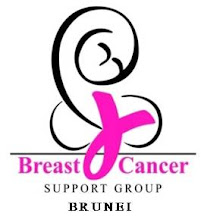Friday 12 March 2010
Monday 1 February 2010
Dispel the Myths
- Finding a lump in your breast means you have breast cancer
- Men do not get breast cancer
- A mammogram can cause breast cancer to spread
- Having a family history of breast cancer means you will get it
- Breast cancer is contagious
- Knowing you have changes in the BRCA1 or BRCA2 gene can help you prevent breast cancer
- Antiperspirants and deodorants cause breast cancer
Tuesday 26 January 2010
Our Profile
The Breast Cancer Support Group was established on 16th September 2001 on the initiative of breast cancer survivors, volunteers and medical professionals. It is a non profit-making support group aim in helping women who are suffering from breast cancer. The Group was officially registered on 14th October 2004.
The main objective of the Group is to provide survivors and their families with emotional support, counselling, and correct information and to help achieve maximum recovery physically, psychologically and cosmetically. It is also a support base for women to share with each other their experience and assist one another with their concerns, fears, frustrations and understanding of the disease and the various treatments available.
Aims and Objectives
· To provide an avenue in supporting each other of their personal experience.
· To help patients overcome the initial psychological shock and emotional trauma following mastectomy or wide-local excision (partial mastectomy/lumpectomy).
· To give information on rehabilitation and coping strategies after breast cancer operation.
· To allay unfounded fears and rumours of the disease.
· To share information on dealing with family members, work colleagues, post-breast surgery exercises, helpful hints on breast prosthesis and alternative dressing costumes.
· To encourage new patients to attend monthly support group meetings.
· To heighten awareness of breast cancer as a major health illness amongst women.
· To promote public education in particular women about health care and breast disease through road shows to schools, civil and private organisations.
The Breast Cancer Support Group hopes that more breast cancer survivors and volunteers will come forward to join and support the cause of the Group in Encouraging, Educate and Support the ever increasing breast cancer patients in this country.
Through this blog, we hope we can continue to educate and at the same time seek your continued support in our work.
